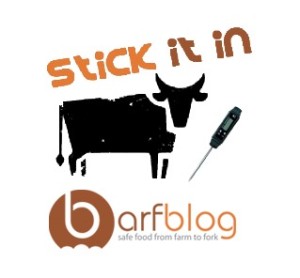Labels aren’t the same as risk communication. And it’s not clear how effective they are as behavior change vehicles.
Information and safe handling labels can provide the basics, if developed in a science-based manner, but as the National Advisory Committee on Meat and Poultry Inspection said in 2014, risk communication folks should really be involved in message crafting and evaluating effectiveness.
The frozen chicken thingie outbreaks are starting to matter. Like these two in 2015.
In an effort to ensure safe eating experiences and address potential consumer confusion, the National Chicken Council (NCC) has petitioned the US Department of Agriculture’s Food Safety and Inspection Service (FSIS) for mandatory labelling of raw, stuffed chicken products that may appear cooked and ready-to-eat.
Specifically, NCC is requesting that the agency take the following actions:
Conduct a rulemaking to adopt a regulation requiring that not-ready-to-eat stuffed chicken breast products that appear ready-to-eat be prominently and uniformly labelled to clearly inform consumers that the products are raw and how to properly handle and cook them; and
Publish a Compliance Guideline explaining how to validate cooking instructions for not-ready-to-eat stuffed chicken breast products that appear ready-to-eat, which incorporates NCC’s “Best Practices for Cooking Instruction Validation for Frozen NRTE Stuffed Chicken Breast Products.”
“NCC increasingly is aware that some consumers may be uncertain of the proper handling and cooking methods for not-ready-to-eat stuffed chicken breast products that may appear ready-to-eat, and the proposed measures are necessary to ensure proper handling and cooking of these products,” said NCC President Mike Brown in the petition.
“This labelling would clearly inform consumers that these products are raw and require proper cooking while providing specific and uniform instructions on how to cook the products.”
FSIS has had labeling guidance out for a while. Making it a rule will help with consistency of info but it’s not a magic bullet.
Oh, and this:
Self-reported and observed behavior of primary meal preparers and adolescents during preparation of frozen, uncooked, breaded chicken products
01.nov.09
British Food Journal, Vol 111, Issue 9, p 915-929
Sarah DeDonder, Casey J. Jacob, Brae V. Surgeoner, Benjamin Chapman, Randall Phebus, Douglas A. Powell
http://www.emeraldinsight.com/Insight/viewContentItem.do;jsessionid=6146E6AFABCC349C376B7E55A3866D4A?contentType=Article&contentId=1811820
Abstract:
Purpose – The purpose of the present study was to observe the preparation practices of both adult and young consumers using frozen, uncooked, breaded chicken products, which were previously involved in outbreaks linked to consumer mishandling. The study also sought to observe behaviors of adolescents as home food preparers. Finally, the study aimed to compare food handler behaviors with those prescribed on product labels.
Design/methodology/approach – The study sought, through video observation and self-report surveys, to determine if differences exist between consumers’ intent and actual behavior.
Findings – A survey study of consumer reactions to safe food-handling labels on raw meat and poultry products suggested that instructions for safe handling found on labels had only limited influence on consumer practices. The labels studied by these researchers were found on the packaging of chicken products examined in the current study alongside step-by-step cooking instructions. Observational techniques, as mentioned above, provide a different perception of consumer behaviors.
Originality/value – This paper finds areas that have not been studied in previous observational research and is an excellent addition to existing literature.


